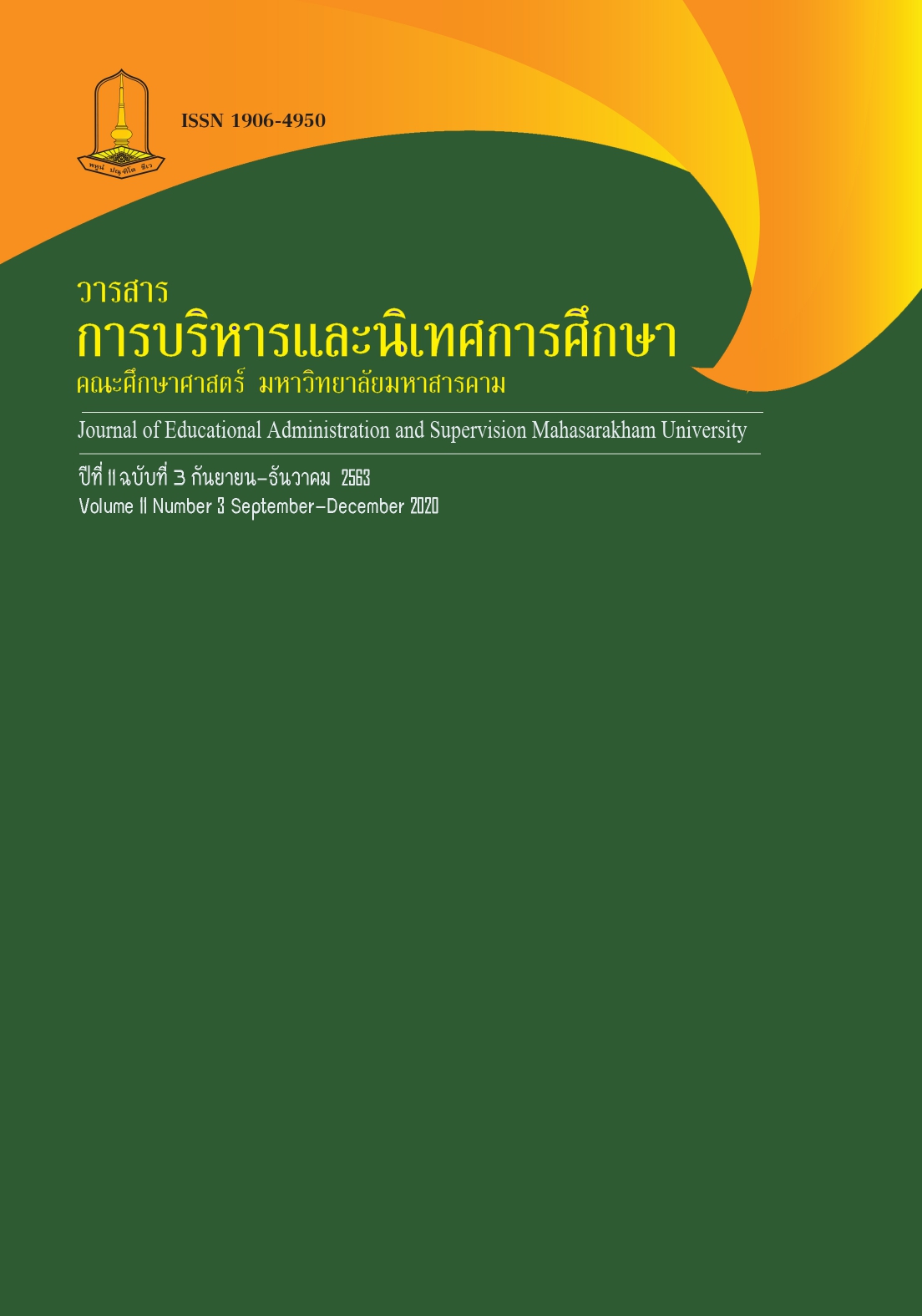The Development of Guidelines for Organizing Learning Environment in Schools under the Secondary Educational Service Area Office 22 in Nakhon Phanom Province
Main Article Content
Abstract
Learning environment of schools was one factor that helped strengthen the learning management to be effective. The purposes of this research were (1) to study current situations and desirable situations for organizing learning environment in schools, (2) to study need assessment for organizing learning environment, and (3) to develop guidelines for organizing learning environment in schools. The samples were 368 school administrators and teachers followed Krejcie & Morgan’s table, and they were selected by Stratified Random Sampling. There were 4 instruments used in this research: (1) a questionnaire in current for organizing learning environment with the index of item congruence (IC) between .60-1.00, the discrimination between .64-.84, and the reliability of .98; (2) a questionnaire in desirable situations for organizing learning environment with the index of item congruence (IC) between .60-1.00, the discrimination between .44-.93, and the reliability of .98; (3) a structured-interview form; and (4) a suitability and possibility assessment form for organizing learning environment . The statistics used were percentage, mean, standard deviation and modified priority needs index. The results were found that (1) overall current situations for organizing learning environment were at the high level, and desirable situations for organizing learning environment in schools were at the highest level. (2) The first aspect of needs assessment for organizing learning environment in schools was learning and teaching management. (3) Overall guidelines organizing learning environment in schools revealed the suitability at the highest level and the possibility at the high level.
Downloads
Article Details
References
กิตติยา โพธิสาเกตุ. (2560). การพัฒนาแนวทางการจัดสภาพการเรียนรู้ภายในสถานศึกษาเอกชนสังกัดอัครสังฆมณฑลท่าแร่ หนองแสง. วิทยานิพนธ์ คศ.ม. มหาสารคาม: มหาวิทยาลัยมหาสารคาม.
ณัฐตะวัน ลิ้มประสงค์. (2558). สภาพการบริหารจัดการชั้นเรียนและสิ่งแวดล้อมเพื่อการเรียนรู้ของสถานศึกษาขนาดเล็ก สังกัดสำนักงานการศึกษาขั้นพื้นฐาน. จังหวัดเพชรบูรณ์: วารสารวิชาการเครือข่ายบัณฑิตศึกษามหาวิทยาลัยราชภัฏภาคเหนือ.
ณัฐภัค อุทโท. (2558). การจัดสภาพแวดล้อมทางการเรียนทางกายภาพของโรงเรียนอนุบาลวัดช่องลม สำนักงานเขตพื้นที่การศึกษาประถมศึกษาชลบุรี เขต 1. ชลบุรี. งานนิพนธ์ (กศ.ม.) มหาวิทยาลัยบูรพา.
ประวีณา โภควนิช. (2559). แนวทางการจัดสภาพแวดล้อมที่เอื้อต่อการเรียนรู้สำหรับสถานศึกษาเรียนรวมระดับประถมศึกษา จังหวัดปทุมธานี. ปทุมธานี. มหาวิทยาลัยเทคโนโลยีราชมงคลธัญบุรี.
พระมหาอำนวย ครองบุญ. (2554). การศึกษาสภาพและความต้องการพัฒนาสิ่งแวดล้อมทางการเรียนของนักเรียนศูนย์ศึกษาพระพุทธศาสนาวันอาทิตย์ในจังหวัดชลบุรี. ชลบุรี. วิทยานิพนธ์ กศ.ม.ชลบุรี: มหาวิทยาลัยบูรพา.
ไพฑูรย์ ศรีฟ้า. (2555). หลักการบริหารโรงเรียน. กรุงเทพฯ: ไทยวัฒนาพานิช.
สำนักคณะกรรมการการศึกษาขั้นพื้นฐาน. (2561). นโยบายสำนักงานคณะกรรมการการศึกษาขั้นพื้นฐาน ปีงบประมาณ 2562. กรุงเทพ ฯ: ชุมนุมสหกรณ์การเกษตรแห่งประเทศไทย.
สำนักงานปลัดกระทรวงศึกษาธิการ. (2559). แผนพัฒนาการศึกษาของกระทรวงศึกษาธิการ ฉบับที่ 12 (พ.ศ. 2560-2564). กรุงเทพฯ: สำนักนโยบายและยุทธศาสตร์.
สายชล วัฒนเกษกรณ์. (2560). แนวทางการบริหารแหล่งเรียนรู้ของสถานศึกษา สังกัดสำนักงานเขตพื้นที่การศึกษาประถมศึกษาอุทัยธานี เขต 2. นครสวรรค์. บัณฑิตวิทยาลัย มหาวิทยาลัยราชภัฏนครสวรรค์.
อมรรัตน์ โคตรชมภู. (2560). การพัฒนาแนวทางการมีส่วนร่วมของชุมชนในการจัดการศึกษาด้านสภาพแวดล้อมของสถานศึกษา สังกัดสำนักงานเขตพื้นที่การศึกษามัธยมศึกษาเขต 21. มหาสารคาม. มหาวิทยาลัยมหาสารคาม.
อรพันธุ์ ประสิทธิรัตน์. (2555). รายงานการวิจัย: การศึกษาสภาพแวดล้อมทางการเรียนของนิสิตคณะศึกษาศาสตร์มหาวิทยาลัยศรีนครินทร์วิโรฒ. กรุงเทพฯ: ภาควิชา เทคโนโลยีทางการศึกษา คณะศึกษาศาสตร์ มหาวิทยาลัยศรีนครินทร์วิโรฒ.
Alessandro. (2007). Learning Environment: Fefiding the Discourse onSchool Architechure. Journal School of Architect, 49(3): 65-82, 2007.
Cloonan, A. (2010). The Connection Between Learning Spaces and Student LearningOutcomes: a Literature Review. Melbourne: Department for Educationand Early Childhood Development.
Cleveland, B. (2015). Developing new approaches to the evaluation of physical learning environments: A return to the origins of post-occupancy evaluation in environmental psychology. University of Melbourne,
Jo O’ Mara. (2010). Australian Bureau of Statistics Census. s.l.: s.n.
Jo-Anne, B. (2014). The Move to Modern Learning Environments in New Zealand Secondary School: Step Forward or Smokescreen. Unites Institute of Technology.


